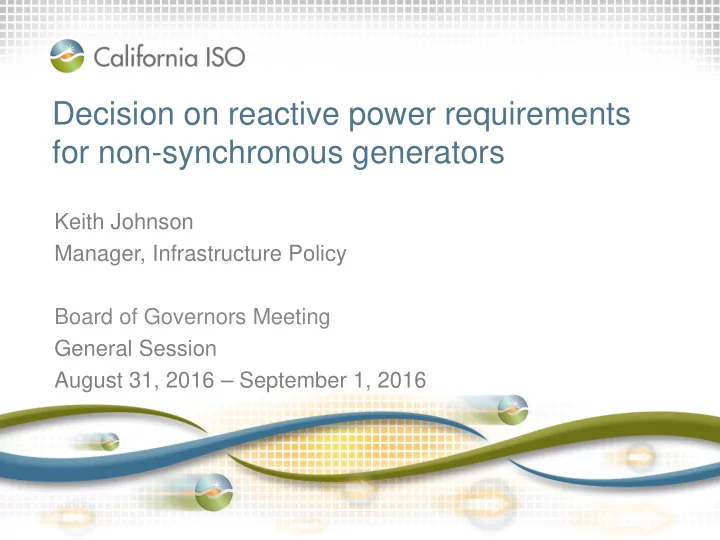

Decision on reactive power requirements for non-synchronous generators Keith Johnson Manager, Infrastructure Policy Board of Governors Meeting General Session August 31, 2016 – September 1, 2016
Management proposes new reactive power requirements for non-synchronous generators that would be applied prospectively. • Propose technical requirements for non-synchronous generators providing reactive power – FERC has issued an order that prescribes requirements – Management is seeking additional requirement for generators to install automatic voltage control equipment so generators can maintain voltage schedules • Management also considered whether the ISO’s current reactive power compensation provisions need to be revised as a result of the new technical requirements Page 2
FERC Order No. 827 includes provisions for new reactive power requirements for non-synchronous generators. • In January, Management suspended its stakeholder initiative to establish reactive power requirements for non-synchronous generators in light of FERC’s rulemaking • In July, FERC issued Order No. 827, which requires – All newly interconnecting non-synchronous generators to have reactive power capability – System impact studies for upgrades to existing generators to determine their reactive power requirements Page 3
Management proposes additional requirement that automatic voltage control equipment be installed. • Order No. 827 does not require automatic voltage control capability – However, it allows for the ISO to propose additional technical requirements in a separate filing – Automatic voltage control is necessary because default mode of operation is for generators to be able to automatically maintain a voltage schedule while operating within specified power factor • Management proposes to make a compliance filing on October 14 that includes – FERC’s ordered requirements – Plus, a separate filing for a requirement for automatic voltage control capability Page 4
Management is not proposing changes to the current financial compensation methodology. • ISO currently compensates generators for the provision of reactive power – When the ISO dispatches a generator down to provide reactive power, it is paid its opportunity cost for any lost energy revenues • Management has determined the current compensation method is appropriate – Method complies with provisions in FERC Order No. 827 – Generators have opportunity to recover capital costs associated with reactive power equipment when they construct or retrofit facilities through power purchase contracts Page 5
Stakeholders support the voltage control capability, but are split on financial compensation. • Stakeholders generally support the automatic voltage control requirement • Regarding financial compensation – Load serving entities believe the ISO’s current compensation method is appropriate – argue equipment has already been paid for in contracts – Generators believe capital costs should be covered through the ISO’s market provisions – Management is concerned with potential double-payments and disruption to bilateral contracting market through introduction of a new capacity payment Page 6
Management recommends the Board approve the proposal for new reactive power requirements for non-synchronous generators. • Proposal will help ensure the ISO can maintain reliable grid operations as non-synchronous generators continue to make up a larger portion of the ISO’s generation fleet • Proposal addresses requirements of FERC Order No. 827 and FERC’s request that the ISO review its current compensation methodology Page 7
Recommend
More recommend